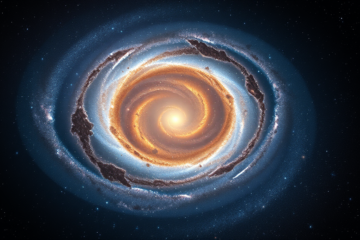Sulfur-33 Compounds in Lunar Rocks
Lunar Sulfur-33 is a fascinating topic that challenges previously held beliefs about the chemical composition of the Moon compared to Earth.
New analysis of lunar samples preserved in a helium tube has revealed the presence of exotic sulfur isotopes not found on our planet.
This article will explore the implications of these findings, discussing the two main hypotheses about the origin of sulfur-33 on the Moon: chemical interactions on the early Moon and the legacy of cataclysmic events related to the Moon's formation.
Through this analysis, we will seek to better understand the history of the Moon and its differences in relation to Earth.
Sulfur-33 Compounds in Lunar Rocks
Recent discoveries about the compounds of sulfur-33 in lunar rocks challenge concepts we have held for decades about the similarity between the chemical compositions of the Moon and Earth.
Using samples preserved in helium tubes collected during the Apollo 17 mission, scientists have identified exotic forms of sulfur-33, which are not present on our planet.
These isotopes reveal isotopic differences significant, indicating that the geochemical history of the Moon may have its peculiarities.
This discovery leads to two main hypotheses: one suggests that the sulfur may have formed through chemical interactions on the early Moon, possibly influenced by interactions with ultraviolet light; the other theory proposes that these compounds may be remnants of the Moon's formation, resulting from the gigantic collision between Earth and Theia, a planetary-sized body.
With future studies planned, investigations aim to determine which of these hypotheses supports the true origin of sulfur-33 lunar.
For more information, check out the article on samples of the Moon brought by Apollo 17.
Sample Preservation and Analysis
Preserving lunar rock samples in helium tubes is a crucial process to ensure the integrity and purity of the materials studied.
By using helium, an inert gas, any interaction with the Earth's atmosphere is avoided, thus preserving the original physical and chemical characteristics of the samples.
This method ensures that scientists can obtain accurate results when analyzing them in the future.
Furthermore, the choice of helium as a preservation agent is due to its ability to form an impenetrable barrier against environmental contaminants.
This procedure is essential for all scientific investigations, especially those that seek to understand the origin and evolution of the Moon.
After preservation, the samples are subjected to modern analytical techniques, such as high-resolution mass spectrometry.
These techniques allow the identification of isotopes never seen before on Earth, like the exotic sulfur-33.
Various researches indicates that these studies reveal information about the differential composition of the Moon and Earth.
To illustrate the workflow, the following table outlines the steps involved:
| Stage | Objective |
|---|---|
| Helium storage | Prevent contamination |
| Spectrometric analysis | Identify unique isotopes |
Hypotheses for the Origin of Lunar Sulfur-33
Study of lunar rocks revealed the presence of sulfur-33, challenging the previous notion that the chemical composition of the Moon and Earth was identical.
Several hypotheses have been proposed to explain this enrichment in sulfur-33, suggesting processes that occurred both on the early Moon and during its formation.
Understanding the origin of this isotope is essential to unraveling the geological history of the Moon and its interactions with Earth.
Photoinduced Chemistry on the Early Moon
The hypothesis of photochemical reaction for the formation of sulfur-33 on the early Moon is fascinating for its scientific implications.
Based on new examinations of samples returned by the Apollo missions, it is understood that these samples preserved for decades in helium tubes contain exotic sulfur isotopes.
One of the proposals suggests that the ultraviolet light intense solar energy played a crucial role in these chemical interactions.
The surface of the Moon, lacking a dense atmosphere, was a favorable environment for these chemical transformations induced by solar radiation.
This photochemical reaction could explain the differences between sulfur compounds found on the Moon compared to those on Earth.
Furthermore, it is important to consider that such processes can reveal details about the conditions of the early Moon and also inform studies of stars lacking protective atmospheres.
For more details on this interesting discovery, NASA discussed these findings in a statement available through NASA website, highlighting the importance of these studies for planetary science.
Legacy of the Collision with Theia
The discovery of isotopes of sulfur-33 in lunar rocks brought new perspectives on the formation of the Moon.
One of the most intriguing theories suggests that these isotopes may be remnants of collision between Earth and the protoplanet Theia.
This impact, which occurred about 4.5 billion years ago, threw debris into space that eventually gave rise to our natural satellite.
Scientists believe that the isotopic composition of these lunar rocks could provide valuable clues about the origin of this material not found on our planet.
Second National Geographic Brazil, the collision with Theia not only contributed to the existence of the Moon, but may also have permanently altered the chemical composition of the Earth.
Furthermore, the possibility that debris from Theia are still present not only on the Moon but also deep within the Earth, as discussed in the article CNN Brazil, offers a fascinating field for future research and exploration.
Thus, understanding the distinct isotopic signature of lunar rocks can not only unlock past secrets, but also guide new discoveries about the evolution of celestial bodies in our solar system.
Directions for Future Research
To the future research about lunar sulfur-33 promise to reveal new mysteries about the origin and composition of the Moon.
This research seeks to understand the difference in isotopic composition between sulfur on Earth and that found in lunar rocks.
Using preserved samples from the Apollo 17 mission, as mentioned on the website [Olhar Digital](Article on exotic lunar sulfur), scientists seek to determine which of the existing hypotheses best explains this phenomenon.
A robust approach is needed to advance this field of study:
- Laboratory experiments simulating the conditions of the early Moon, investigating the interaction of sulfur with ultraviolet light.
- Comparative analysis with sulfur isotopes from different terrestrial and meteoritic sources.
- Computer simulations of post-collision scenarios with Theia to recreate the formation of the Moon and its compositions.
- Future field studies on lunar missions, collecting new samples for direct observation and experimentation.
These techniques will allow a deeper understanding of how these isotopes were formed and differ from those found on our Earth.
Lunar Sulfur-33 offers new insights into the formation and composition of the Moon, highlighting the need for further research to unravel its origins.
Future investigations will be crucial in determining which of the sulfur hypotheses is most plausible, further illuminating our understanding of the Earth-Moon system.



0 Comments